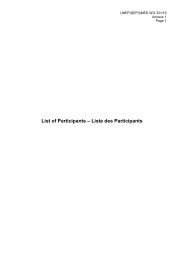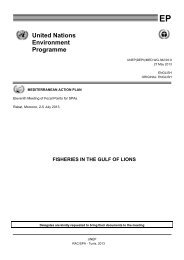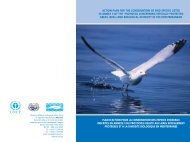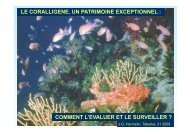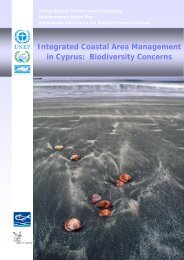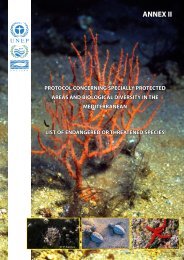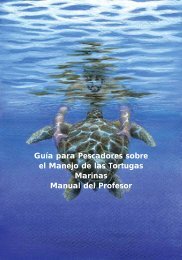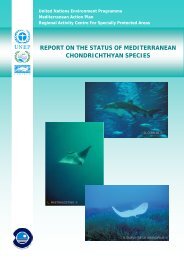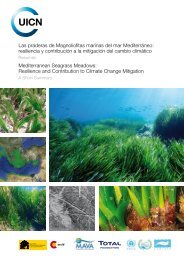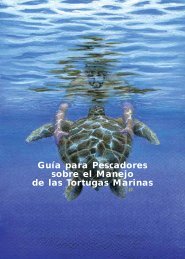Proceedings of the Second Mediterranean Symposium on Marine
Proceedings of the Second Mediterranean Symposium on Marine
Proceedings of the Second Mediterranean Symposium on Marine
You also want an ePaper? Increase the reach of your titles
YUMPU automatically turns print PDFs into web optimized ePapers that Google loves.
PROCEEDINGS OF THE SECOND MEDITERRANEAN SYMPOSIUM ON MARINE VEGETATION (ATHENS, 12-13 DECEMBER 2003)<br />
212<br />
diving at deeper depths would decrease <str<strong>on</strong>g>the</str<strong>on</strong>g> method's cost-effectiveness ratio (Pagola-<br />
Carte et al., 2002). Photographic sampling was performed <strong>on</strong> photophilous<br />
phytobenthic populati<strong>on</strong>s in May 2003 by a NIKONOS V camera with a Morris Aqua F-<br />
III TTL Flash System. Ten photoquadrats (40X80cm) were sampled for each site, <str<strong>on</strong>g>the</str<strong>on</strong>g> first<br />
<strong>on</strong>e being randomly selected while <str<strong>on</strong>g>the</str<strong>on</strong>g> o<str<strong>on</strong>g>the</str<strong>on</strong>g>r nine following at equal distances.<br />
At lab, a transparent grid divided in 100 equal squares was overlapped <strong>on</strong> each<br />
photosample to calculate percentage coverage values for all c<strong>on</strong>spicuous species. Where<br />
identificati<strong>on</strong> down to species level was not possible, organisms were aggregated into<br />
groups <str<strong>on</strong>g>of</str<strong>on</strong>g> similar morphological and functi<strong>on</strong>al charasteristics (see Terlizzi et al., 2002),<br />
thus unaffecting <str<strong>on</strong>g>the</str<strong>on</strong>g> Ecological Evaluati<strong>on</strong> Index.<br />
Ecological Evaluati<strong>on</strong> Index<br />
The Ecological Evaluati<strong>on</strong> Index (EEI) was applied <strong>on</strong> <str<strong>on</strong>g>the</str<strong>on</strong>g> quantified data. The Index is<br />
based <strong>on</strong> <str<strong>on</strong>g>the</str<strong>on</strong>g> functi<strong>on</strong>al diversity <str<strong>on</strong>g>of</str<strong>on</strong>g> macrophytobenthic populati<strong>on</strong>s.<br />
Species were classified into two Ecological State Groups, namely:<br />
• ESG I comprising <str<strong>on</strong>g>the</str<strong>on</strong>g> late successi<strong>on</strong>al species, that is species with thick or calcareous<br />
thallus, low growth rates and l<strong>on</strong>g life cycles (mostly K-selected species).<br />
• ESG II comprising <str<strong>on</strong>g>the</str<strong>on</strong>g> opportunistic species, sheet-like and filamentous organisms, with<br />
high growth rates and short life cycles (mostly r-selected species)<br />
Mean absolute coverage values <str<strong>on</strong>g>of</str<strong>on</strong>g> ESGI and ESGII were <str<strong>on</strong>g>the</str<strong>on</strong>g>n cross compared in an<br />
ad hoc modulated matrix (Fig. 1) to result in <strong>on</strong>e <str<strong>on</strong>g>of</str<strong>on</strong>g> <str<strong>on</strong>g>the</str<strong>on</strong>g> five WFD Status Categories<br />
(High, Good, Moderate, Low or Bad).<br />
Figure 1: Matrix based <strong>on</strong> mean abundances <str<strong>on</strong>g>of</str<strong>on</strong>g> ESGI and ESGII to determine <str<strong>on</strong>g>the</str<strong>on</strong>g> ecological status <str<strong>on</strong>g>of</str<strong>on</strong>g> a coastal<br />
area (from Orfanidis et al., 2001)



